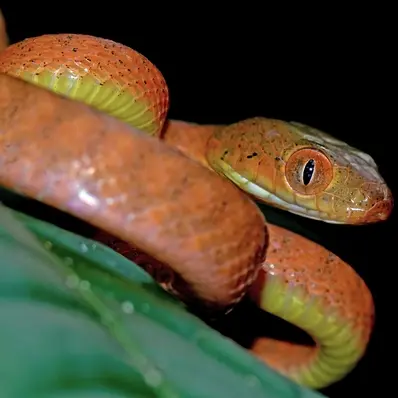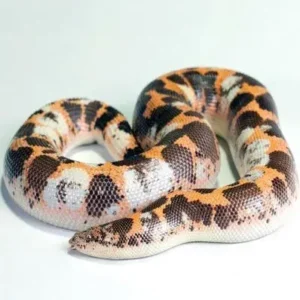Origin
The Red Tail Boa, scientifically known as the Boa constrictor imperator, traces its roots to the lush and diverse rainforests of Central and South America.
- Habitat
Displaying an arboreal lifestyle, these boas utilize trees and branches for both hunting and shelter, showcasing their agility and adaptability.
Their semi-aquatic tendencies see them near bodies of water, where they engage in activities like swimming for hydration and thermoregulation. The consistent warmth and high humidity levels of the rainforest contribute to their well-being.
Replicating these conditions is essential in captivity, ensuring a suitable habitat with climbing opportunities and careful attention to temperature and humidity gradients.
Personality
Known for their captivating combination of beauty and docility, Red Tail Boas (Boa constrictor imperator) is recognized as one of the more manageable species of snakes. With a calm demeanor and the ability to form bonds with their owners, these boas make appealing companions.
Red Tail Boas are non-venomous, relying on constriction rather than venom. They are not defensive unless they sense a serious threat, contributing to their overall ease of management.
This mild temperament makes them suitable for both experienced reptile enthusiasts and those new to snake ownership.
Physical Appearance
Red Tail Boas (Boa constrictor imperator) boasts a striking physical appearance, making them stand out among snake enthusiasts.
Here’s a closer look at their distinctive features:
- Size
A full-grown red tail boa is impressive in size, ranging from 6 to 10 feet in length. This substantial size contributes to their majestic presence, captivating those who appreciate larger snake species.
- Coat Color
The body displays a simple color palette with base colors including light brown, tan, and grayish brown. A distinguishing feature is the red/brown tail, intensifying with age.
These neutral tones are complemented by cream hues, adding a subtle contrast to the overall appearance of the snake. The combination of these colors gives Red Tail Boas a straightforward yet distinct look appreciated by snake enthusiasts.
The overall pattern may vary, showcasing a mix of intricate markings and solid colors.
Gender Differences
Male and female Red Tail Boas generally exhibit similar physical characteristics, making it challenging to differentiate based on appearance alone.
Experienced breeders may be able to identify gender through probing or by observing behavior during breeding seasons.
Feed/Nutrition
Red Tail Boas undergo a straightforward dietary progression. Starting as juveniles, they should be fed fuzzies and gradually advance to mice, rats, rabbits, and larger rats as adults. This gradual transition ensures their nutritional needs are met at each stage of development.
- Feeding Practices
To establish a healthy feeding routine, it is recommended to conduct feeding sessions in a separate enclosure dedicated solely for this purpose.
In pet boas, this practice helps avoid associating the owner with food. It reduces the risk of accidental bites during handling and promotes a more natural feeding response from the boa.
Health
Maintaining proper temperatures and humidity in their enclosure is crucial for the health of Red Tail Boas. Regular veterinary check-ups are recommended to monitor their overall well-being.
- Inclusion Body Disease (IBD): Red Tail Boas can be affected by Inclusion Body Disease (IBD), a serious retrovirus similar to HIV in humans. IBD is a potentially fatal condition, emphasizing the importance of regular veterinary check-ups and vigilant symptom monitoring.
- Respiratory Diseases: Red Tail Boas are susceptible to respiratory infections, which can pose a threat to their overall health. Recognizing the signs and understanding preventive measures are crucial for boa owners.
Red Tail Boa Care
Keeping a red tailed boa in captivity requires one to consider their size, age, and specific environmental needs. To ensure proper care, mimicking its natural habitat is very important.
- Housing
When it comes to housing an adult Boa constrictor imperator, providing a spacious enclosure is paramount. Aim for a minimum of 10 feet of floor space, with dimensions a couple of feet high and wide.
Security is crucial, so enclosures should be equipped with locks to prevent any potential escapes. To ensure optimal humidity levels ranging from 60-80%, consider enclosures with glass or plexiglass sides and lids. Include a properly-sized water bowl and a hide box to enhance their comfort and well-being.
- Lighting and Heating
Creating a suitable environment for Red Tail Boas involves attention to heating preferences. Maintain a basking spot within the range of 90-92 degrees Fahrenheit to accommodate their preference for warmth.
Heating options include heat lights, ceramic heat emitters, under-tank heaters, or incubator cages. While UVB lighting is not mandatory, it can offer additional benefits such as appetite stimulation and stress reduction, contributing to the overall health and contentment of your Red Tail Boa.
Rescue Groups
For those looking to adopt a Red Tail Boa, consider reaching out to reputable reptile rescue groups. These organizations often have snakes in need of loving homes.
Red Tail Boa for Sale
If you’re considering purchasing a Red Tail Boa, ensure you choose a reputable breeder who practices ethical breeding and cares for the well-being of their snakes.
Interesting Facts
- Red-tailed boas are known for their ability to change color depending on their mood, temperature, and environment.
- They are excellent swimmers and can stay underwater for up to 30 minutes.
- Their constriction technique aids in subduing prey before swallowing it whole.
Best For
Red Tail Boas (Boa constrictor imperator) are ideal for enthusiasts seeking a captivating and manageable large snake species.
Top Names
| Male Boa Constrictor Names | Female Boa Constrictor Names |
| Venom | Mystique |
| Shadow | Seraphina |
| Rex | Nova |
| Zephyr | Willow |
| Cobalt | Aria |










